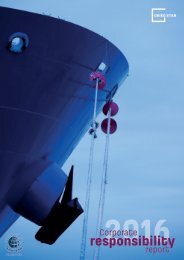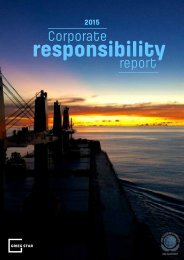Create successful ePaper yourself
Turn your PDF publications into a flip-book with our unique Google optimized e-Paper software.
Note 17<br />
Financial market risk<br />
The Group uses various financial derivatives to manage its financial market risk. This includes forward contracts, options, interest rate<br />
swaps and forward rate agreements.<br />
Interest rate risk<br />
Interest rate risk arises in the short and long term as the Group’s debt are held at a floating rate of interest. The Group’s strategy is<br />
to hedge the Group’s net interest rate exposure (cash flow hedging). A change in interest rates will result in either an increase or a<br />
reduction of the financing cost. If certain interest rate derivatives are applied then the predictability of the financing cost will increase<br />
due to a limitation of the net effect of a change in interest rates. In addition a change in interest rates will affect the returns on the<br />
investment portfolio and the rates on cash deposits. As a principle, the company has a certain level of hedging (30%-50%) using market-based<br />
hedging instruments. In this case, interest rate swap agreements are mainly used. Gains and losses arising from interest<br />
rate swaps are recognised in the same period as the related interest expense.<br />
At 31.12.14 the Group had signed interest rate swap agreements totalling USD 259 m (including forward interest rate swap agreements),<br />
directly hedging 45% (YE<strong>2014</strong>) of the Group’s future interest rate risk. At the same date, the unrealised loss attached to these agreements,<br />
and not posted in the balance sheet, was a loss of USD 17.5 m with an average period of maturity of 4.7 years.<br />
Foreign exchange risk<br />
The Group’s main focus in relation to foreign exchange hedging is to ensure that costs and liabilities are denominated in the same<br />
currency as revenue and assets. As the Group’s basic currency is the USD, its strategy is to ensure that it covers its currency exposure<br />
related to administration costs, operating costs, tax and dividend payments that are denominated in another currency than USD. In this<br />
connection, the Group is mainly exposed to NOK, followed by EUR and CAD. The NOK exposure is largely covered through forward<br />
foreign exchange contracts. Gains/losses on foreign exchange contracts are booked in the same period as the period when the hedged<br />
transactions are settled. Non-USD denominated financial investments which are part of the Group’s financial investment portfolio are<br />
also taken into consideration when the Group’s net foreign exchange exposure is assessed.<br />
At 31.12.14 the Group had entered into forward contracts/foreign exchange accumulators to hedge a total of USD 57 m. The realized<br />
gain on these contracts was USD 0.1 m in 31.12.14. The contracts had an unrealized, not posted gain in the balance sheet, of USD 0.7 m<br />
at 31.12.14.<br />
Freight rate risk<br />
The shipping industry is cyclical and characterised by large and volatile fluctuations in freight rates and furthermore revenues. As<br />
part of the Group’s risk management, Forward Freight Agreements (FFA) are from time to time used as a risk managment instrument.<br />
The Group’s shipping activities are of an industrial nature which makes it possible to cover exposure to spot rates by entering into<br />
long-term cargo contracts. As a result, the Group’s revenue fluctuate less than is the case when operating in the general dry bulk spot<br />
market. The FFA contracts are settled as an adjustment of operating income.<br />
Bunker price risk<br />
The Group uses derivative contracts to hedge bunker prices related to freight agreements without bunker clauses. The result of the<br />
hedging contracts is classified as an adjustment of operating costs and is posted in the hedging period.<br />
As of 31.12.14, the Group had made derivative contracts to hedge bunker prices for a total of 9,600 mt bunkers. Included bunker clauses,<br />
this gives a hedging rate of 100 % of budgeted bunker consumption for <strong>2014</strong>. As of 31.12.<strong>2014</strong>, unrealized, not posted, losses on<br />
financial bunkers hedging was USD -2.44 m.<br />
GRIEG STAR<br />
<strong>2014</strong><br />
30<br />
ANNUAL REPORT







